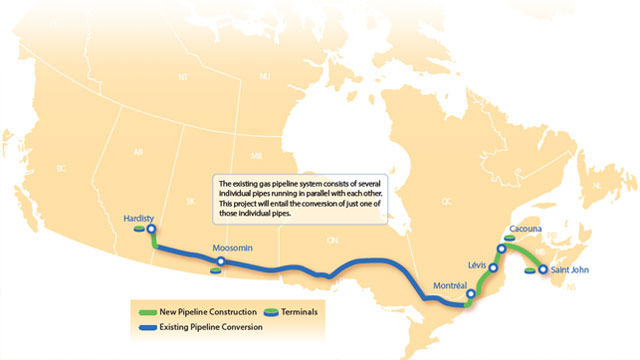May 2015, Vol 242, No. 5
Features
Long Road Ahead for Energy East Pipeline in Canada

Canada’s National Energy Board (NEB) has been inundated by 1,800 applications from those interested in participating in hearings on the proposed Energy East oil pipeline that would carry over MMbpd from Western Canada to export terminals on the country’s Atlantic coast.
The applicants, ranging from individuals to provincial governments, want to highlight the environmental risks of TransCanada Corp.’s $12 billion, 2,850-mile pipeline – a combination of existing pipelines and new construction – from Alberta through Quebec to the Irving Canaport terminal at the entrance to St. John Harbor in coastal New Brunswick.
Among the applicants is the Government of New Brunswick (GNB), which said it wants “the ability to have input regarding the terms and conditions to be included in any recommendation or approval the National Energy Board may issue for the project” because it must administer and enforce environmental laws and regulations associated with the pipeline.
The applications seem to be copies of a single letter that was distributed online by two environmental groups, 350.org and Greenpeace. The document included detailed instructions for individuals and organizations to apply for participation in the hearings. The applications cite concern for Canada’s environment, and each includes this sentence: “Energy East would facilitate 32 million tons of carbon dioxide emissions being produced each year, the same as adding over 7 million cars to Canada’s roads, and greater than the climate footprint of an Atlantic province.”
Katherine Murphy, a spokeswoman for the NEB, told the Financial Post that the board isn’t authorized to “look at climate change at large,” but added that the concerns mentioned in the applications were appropriate to the hearings. “[W]e would be looking at the greenhouse gas emissions as a result of the construction process,” she said.
Murphy said the board was evaluating the applications to decide which ones would be allowed to participate in the hearings. The NEB website said that in order to participate in the hearing, an individual, organization or government “must be directly affected or have relevant information or expertise.” She said the NEB is studying TransCanada’s application to determine if it’s “sufficiently complete.”
If so, she said, the board “will issue a hearing order along with the list of participants. If this is the case, we would anticipate these documents to be released mid-year 2015.” Murphy said that would lead to setting a date for the hearings to begin. If approved, construction of the pipeline could begin in 2016 and be ready to transport crude in 2018. It’s also expected to create over 2,000 jobs during construction.
But the project is strongly opposed by environmental groups, which say it would endanger drinking water, wildlife habitat, tourism and the cultures and treaty rights of First Nation peoples which have applied to participate in the hearings to express concern about possible pipeline spills in their areas.
“Putting all kinds of new stresses on decades-old pipe designed for transporting natural gas is very threatening to our waterways,” Eagle Lake Chief Madeleine Paul said in a statement.





Comments